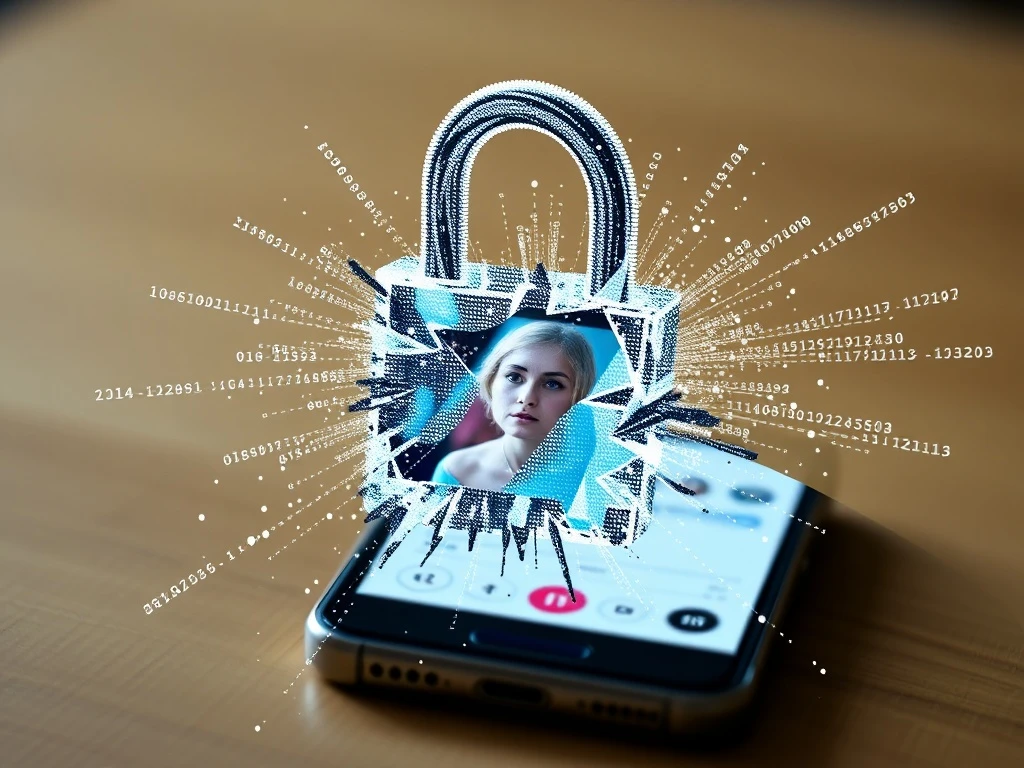Catastrophic Tea App Data Breach: AI Code Security Exposes 72,000 Users

In the world of cryptocurrency, where self-custody and decentralized security are paramount, news of a major centralized platform suffering a devastating security failure hits differently. While blockchain technology aims to minimize single points of failure, traditional applications, even those promising enhanced safety, remain vulnerable. The recent Tea App data breach is a stark reminder of these risks, exposing a staggering 72,000 user records and highlighting a critical flaw in modern software development: over-reliance on AI-generated code without proper scrutiny. This incident underscores why vigilance in cybersecurity is more crucial than ever, whether you’re managing crypto assets or personal data on a dating app.
The Alarming Scope of the Tea App Data Breach
The Tea App, a women-only dating safety application that soared to the top of the App Store charts with millions of users, has faced a catastrophic security incident. This Tea App data breach is not just a minor leak; it’s a full-scale exposure of highly sensitive personal information, contradicting the app’s core promise of providing a secure environment for its users. The breach, initially uncovered on 4chan, revealed that the app’s backend database was shockingly unsecured, lacking basic safeguards like passwords, encryption, or authentication.
- Scale of Exposure: Over 72,000 user records compromised.
- Data Volume: A massive 59.3 GB of leaked data.
- Sensitive Information: This includes approximately 13,000 verification selfies and government-issued IDs, tens of thousands of user-generated images, and private messages dating from as recently as 2024 and 2025.
- Public Availability: Verification documents are now publicly searchable on decentralized platforms like BitTorrent, where automated scripts continue to spread the data, making it incredibly difficult to contain.
Tea App’s initial claims that the breach involved only ‘old data’ have been unequivocally debunked by the timestamps on the leaked information, underscoring a profound failure in their security infrastructure and transparency.
When AI Code Security Goes Wrong: The ‘Vibe Coding’ Vulnerability
The root cause of this massive security failure points directly to a concerning trend in software development: the practice of ‘vibe coding.’ This term refers to developers relying heavily on AI tools like ChatGPT to generate code without conducting rigorous security reviews or understanding the underlying implications. In the case of Tea App, the original hacker identified that the app’s Firebase bucket, a cloud storage service, was configured by default to be publicly accessible and lacked any authentication whatsoever. This is a fundamental misconfiguration that could have been easily prevented with proper due diligence.
The reliance on AI for core functionalities, without sufficient human oversight, introduces significant vulnerabilities. Research from Georgetown University has sounded the alarm, revealing that nearly half (48%) of AI-generated code contains exploitable flaws. Despite this alarming statistic, a substantial portion (25%) of Y Combinator startups, often at the forefront of innovation, are reportedly using such code for their core features. Cybersecurity experts, including Santiago Valdarrama, have publicly criticized this trend, emphasizing that while AI can accelerate development, it often generates code that lacks the robust safeguards necessary to prevent devastating breaches. This incident serves as a critical case study on why meticulous human review of AI code security is non-negotiable.
Why Your User Data Exposed Matters: Beyond Just Privacy
The implications of having your user data exposed go far beyond a simple invasion of privacy. For the 72,000 affected Tea App users, the risks are tangible and severe:
- Identity Theft: With government-issued IDs and verification selfies now public, bad actors have all the necessary information to commit identity theft, open fraudulent accounts, or even apply for loans in victims’ names.
- Harassment and Stalking: An app designed to protect women from ‘dangerous men’ has ironically exposed its users to potential harassment and stalking, given the availability of private messages and personal images.
- Targeted Scams and Social Engineering: The detailed personal information, including private conversations, can be used by malicious actors to craft highly convincing phishing attacks or social engineering scams tailored to individual victims, making them incredibly difficult to detect.
- Reputational Damage: The exposure of private messages and images can lead to severe reputational harm, affecting personal and professional lives.
The fact that this sensitive data is now freely circulating on decentralized networks like BitTorrent makes it nearly impossible to recall or remove, ensuring a long-term threat to the affected individuals. This permanent exposure highlights the profound consequences when an application fails to secure the very data it promises to protect.
Lessons from a Cybersecurity Lapse: A Wake-Up Call for Developers
The Tea App incident serves as a chilling example of a profound cybersecurity lapse, offering critical lessons for all developers and tech companies, especially those leveraging AI:
- No Substitute for Security Audits: Expediency should never trump security. Relying on AI for code generation does not negate the need for rigorous security audits, penetration testing, and vulnerability assessments.
- Default-Secure Configurations: Databases and cloud storage solutions should always default to the most secure settings, requiring explicit configuration changes to open access. Public accessibility should never be the default for sensitive data.
- Transparency and Accountability: Tea App’s delayed and misleading communication about the breach further eroded user trust. Companies must have clear incident response plans and be transparent with affected users about what data was compromised, when, and what mitigation steps are being taken.
- The AI Paradox: While generative AI offers incredible potential for accelerating development, it also introduces new attack vectors and vulnerabilities. Developers must understand the limitations and potential flaws of AI-generated code and integrate robust human oversight into their development pipelines. The SaaStr 2025 incident, where an AI agent deleted a company’s production database, further underscores the systemic risks associated with unchecked AI integration.
This incident is a stark reminder that even apps designed with noble intentions can become a significant liability if foundational security practices are neglected. The irony of a ‘safety’ app failing so spectacularly to secure its own data will undoubtedly be a case study for years to come.
Protecting Your Digital Footprint: Navigating Data Privacy in a Connected World
For individuals, especially those whose data privacy has been compromised by the Tea App breach, immediate action is crucial. While the data is now out there, steps can be taken to mitigate further harm:
- Monitor Accounts: Regularly check your financial accounts, credit reports, and online profiles for any suspicious activity. Consider placing a fraud alert or freezing your credit.
- Change Passwords: If you used the same password for Tea App as for other services, change those passwords immediately. Use strong, unique passwords for all accounts.
- Enable Multi-Factor Authentication (MFA): Wherever possible, enable MFA. This adds an extra layer of security, making it harder for unauthorized users to access your accounts even if they have your password.
- Be Wary of Phishing: Be extra cautious of unsolicited emails, messages, or calls, especially those claiming to be from Tea App or related services. Cybercriminals often use leaked data to craft highly personalized phishing attempts.
- Educate Yourself: Understand common scam tactics and how to identify them. The more informed you are, the better equipped you’ll be to protect yourself.
The Tea App breach serves as a powerful cautionary tale, emphasizing that no platform, regardless of its niche or branding, can afford to compromise on fundamental security. In an increasingly interconnected world, proactive measures and a critical eye towards how our personal data is handled are paramount for maintaining our digital safety and privacy.
The Tea App data breach is a sobering reminder that innovation, especially with AI, must be paired with unwavering commitment to security. The exposure of 72,000 users’ most intimate details due to a basic cybersecurity lapse stemming from unchecked AI-generated code highlights a critical industry-wide challenge. This incident should compel developers to adopt a security-first mindset, prioritize robust audits, and never underestimate the value of human oversight in an AI-driven world. For users, it’s a stark call to action: remain vigilant, protect your digital footprint, and demand greater accountability from the platforms you trust with your personal information.
Frequently Asked Questions (FAQs)
Q1: What exactly happened in the Tea App data breach?
The Tea App, a women-only dating safety app, suffered a catastrophic data breach exposing over 72,000 user records. This included sensitive information like government-issued IDs, verification selfies, user-generated images, and private messages. The breach occurred because the app’s backend database was left unsecured, lacking passwords, encryption, or authentication.
Q2: How was AI-generated code involved in this security lapse?
The security lapse has been attributed to ‘vibe coding,’ a practice where developers rely on AI tools like ChatGPT to generate code without rigorous security reviews. In Tea App’s case, the original hacker noted that the Firebase bucket was configured by default to be publicly accessible, likely due to an oversight or flawed AI-generated configuration that wasn’t properly checked.
Q3: What are the risks for users whose data was exposed?
Affected users face significant risks including identity theft, as government IDs and selfies are now publicly available. They are also vulnerable to harassment, targeted scams, and social engineering attacks, as private messages and other personal details have been compromised. The data is spreading on decentralized platforms, making it difficult to remove.
Q4: What should affected users do to protect themselves?
Users should immediately monitor their financial accounts and credit reports for suspicious activity. It’s advisable to change passwords for any accounts that shared credentials with Tea App and enable multi-factor authentication (MFA) wherever possible. Additionally, be extremely cautious of any unsolicited communications, as they could be phishing attempts.
Q5: What lessons can the tech industry learn from this Tea App data breach?
This incident underscores the critical need for rigorous security audits, even when using AI-generated code. Developers must prioritize default-secure configurations for databases and cloud services. Companies must also enhance transparency and accountability in their incident response, and recognize that while AI can accelerate development, it requires significant human oversight to prevent new vulnerabilities.









